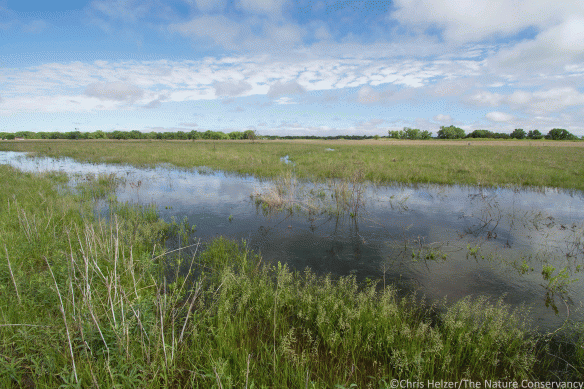Underwater Prairie
 Our changing climate is already bringing us some pretty intense weather variability. The current iteration of that variability has been flooding across much of Nebraska [and Iowa] this spring. I’ve escaped serious damage to property so far, both at work and at home, but I know of many others that have not been so lucky.
Our changing climate is already bringing us some pretty intense weather variability. The current iteration of that variability has been flooding across much of Nebraska [and Iowa] this spring. I’ve escaped serious damage to property so far, both at work and at home, but I know of many others that have not been so lucky.
On Sunday night, we received about 3 inches of hard rain on top of already saturated soil at our Platte River Prairies. We didn’t have any damage to infrastructure but much of the lower elevation prairie was underwater Monday morning.
I spent a few hours Monday morning trying to catch up on some data collection before taking the rest of the day off. Identifying plants within a plot frame became a little more challenging than I’d expected since many of my sampling locations were covered by up by a few inches of gently flowing (but fortunately clear) water. I was still able to collect the data I needed, but it was a little slower, and a lot more splashy than I’d expected.
As I walked and worked across the prairie Monday morning, I couldn’t help noticing all the invertebrates that had been displaced by the water. Ants, spiders, beetles, pill bugs, and many others were climbing and clinging to plants above the water that was flowing gently across the prairie. I spotted a few carcasses, but for the most part, it looked like everything was surviving pretty well.
When we talk about the ecological resilience of prairies around here, especially related to climate change, we tend to focus on droughts. Planning for more frequent, intense and prolonged droughts has become a necessity for all of us living on the Great Plains. However, drought isn’t the only severe weather a changing climate will bring. We are already experiencing more intense storm events, some of which trigger flooding.
From a pure ecological standpoint, most prairies are pretty adapted to periodic flooding. The exception is the kind of massive flooding that dumps huge loads of sediment on top of prairies, washes them away completely, or inundates them for long enough to kill all the vegetation. Those kinds of floods certainly happen – they’ve occurred a few times in the last decade along the Missouri River, for example, and some grassland areas (mainly restored grasslands) have disappeared as a result.
In the case of our Platte River Prairies and the kind of temporary flooding we’re currently experiencing, however, I’m not too worried. I’ve seen these prairies flooded for many days at a time, and by just a few weeks after drying up, they look like nothing ever happened (except for some big logs and other detritus left behind by the water). Prairie plants are pretty tough, and most don’t seem to have trouble hanging in there until the water subsides. Our biggest worry during events like these is related to invasive species – flood waters can bring in seeds and rhizomes of some nasty plants, so we will have to be vigilant about patrolling flooded areas over the next few years.
Of course, plants aren’t the only species that have to deal with prairie flooding. Birds and other flying creatures can find high ground pretty easily, though ground-level nests might not fare so well. Other mobile animals have a good chance of getting to high ground, either by walking ahead of the water or swimming through it.
Animals living beneath the ground can have special challenges. I don’t know about all burrowing animals, but I know ant colonies can survive flooding because of the air pockets trapped in their underground nests. In fact, back in 2011, I posted photos of the ant activity after flood waters receded and all the colonies started repairing their nests at the same time. I assume a lot of other burrowing animals besides ants can take advantage of the same kind of trapped air, at least for a while. If not, I guess they either drown or pop up to the water’s surface and swim for a while!
It rained another inch on Monday night, further adding to the flow of water across most of our sites. I assume the rain will stop at some point (and we might be really wishing for rain by mid-summer) but in the meantime, I’ll rely on the resilience of prairies and their resident species to get through this. I just hope all those insects can hold on to their stems for a few more days!
Originally published on The Prairie Ecologist.


